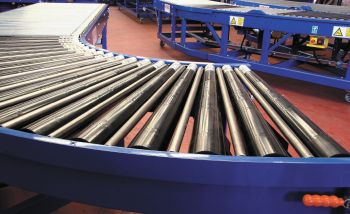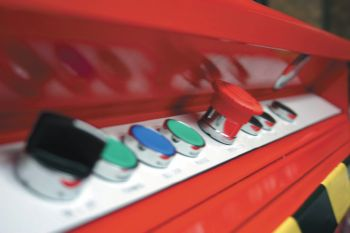 The current economic climate is forcing businesses to scrutinise their budgets and reduce costs. Refurbishing conveyors is a viable, realistic option, and companies would be wise to consider it before scrapping old systems, says Steve Nuttall, sales director at Sovex Systems
The current economic climate is forcing businesses to scrutinise their budgets and reduce costs. Refurbishing conveyors is a viable, realistic option, and companies would be wise to consider it before scrapping old systems, says Steve Nuttall, sales director at Sovex Systems
Conveyor systems installed 20 to 30 years ago are now reaching the end of their working lives, leaving companies to foot the bill. Although keeping conveyors up to date and running efficiently is essential to most parcel handlers, funds to replace worn equipment can be difficult to source due to the current economic climate.
For businesses looking to reduce costs, there are other options. Old conveyor systems that have become inefficient may be eligible for refurbishment. With the proper engineering, refurbished conveyors run just as well as new ones, and come with extended guarantees to prove it.
Compared to buying new equipment, refurbishing conveyor systems is cost effective and leads to substantial time savings. However, companies should first carry out an assessment to ascertain viability.
Refurbishment viability
A refurbishment viability assessment will establish whether the existing conveyor layout will meet future needs. Anticipated business growth may increase throughput requirements and necessitate a bigger system. Companies should also survey existing equipment to check its condition and performance potential.
If a refurbishment is viable, there are a number of conveyor manufacturers that can help. They usually dismantle each unit for a thorough overhaul, and then test, repair or replace components such as motors, belts, rollers, chains, wire ropes, bearings, limit switches, gravity product sensors, halogen lights and control buttons.
Refurbishment contractors can also supply new control panels and completely rewire equipment to ensure it meets current legislation. In the case of telescopic boom conveyors, they will replace all internal components, clean the machines down to bare metal, and respray them to look as new.
Replacing control systems
Although the mechanical components of conveyors are easy to refurbish or upgrade, control devices and systems are different. Manufacturers used to fit units with binary flags, photocells and self-adhesive reflectors: dated technologies that no longer meet the requirements of busy parcel handlers.
Companies should consider fitting refurbished conveyors with modern control systems, which use lasers, absolute encoders and frequency inverters to detect the position of every item on the line. They route and divert parcels automatically, and manage the entire operation at high speed. Fitting modern control systems to refurbished conveyors can greatly improve their performance.
Modern operating software
 Businesses refurbishing conveyors may also need to replace the operating software. Operating software is highly complex and performs a wide range of functions. These include matching orders to pallet loads, controlling the storage locations of pallets, and keeping detailed records on the shelf lives of products and how long they have been in storage.
Businesses refurbishing conveyors may also need to replace the operating software. Operating software is highly complex and performs a wide range of functions. These include matching orders to pallet loads, controlling the storage locations of pallets, and keeping detailed records on the shelf lives of products and how long they have been in storage.
In the 1980s and 1990s, operating software for conveying systems was highly bespoke, time-consuming to develop, and cost many hundreds of thousands of pounds. It has advanced radically over the last 10 years.
Today’s software features improved functionality at a lower cost. Plus, off-site commissioning leads to significant time savings. Using modern operating software to run refurbished conveyors helps ensure their efficient operation.
Safety legislation
Health and safety at work has become increasingly important over the last 30 years. There are now comprehensive regulations and employers have a legal duty to protect their staff. They are also liable for accidents that occur.
If someone dies as a result of an accident at work, companies can face criminal prosecution under the new Corporate Manslaughter Act, introduced in April last year. This is punishable by an unlimited fine, which could potentially bankrupt a business.
In the UK, conveyors fall under the Provision and Use of Work Equipment Regulations (PUWER) 1998. These specify work equipment must be suitable for use, maintained in a safe condition and regularly inspected to ensure it stays this way.
Conveying systems built in the 1980s and 1990s may not comply with this legislation, so companies carrying out refurbishments must bring the equipment up to date.
This includes making controls accessible and marking them clearly to allow operators to switch off a machine if an accident occurs; adding emergency stop buttons; and covering dangerous areas, for example, the areas where the sections retract on a telescopic boom conveyor, with guard plates.


